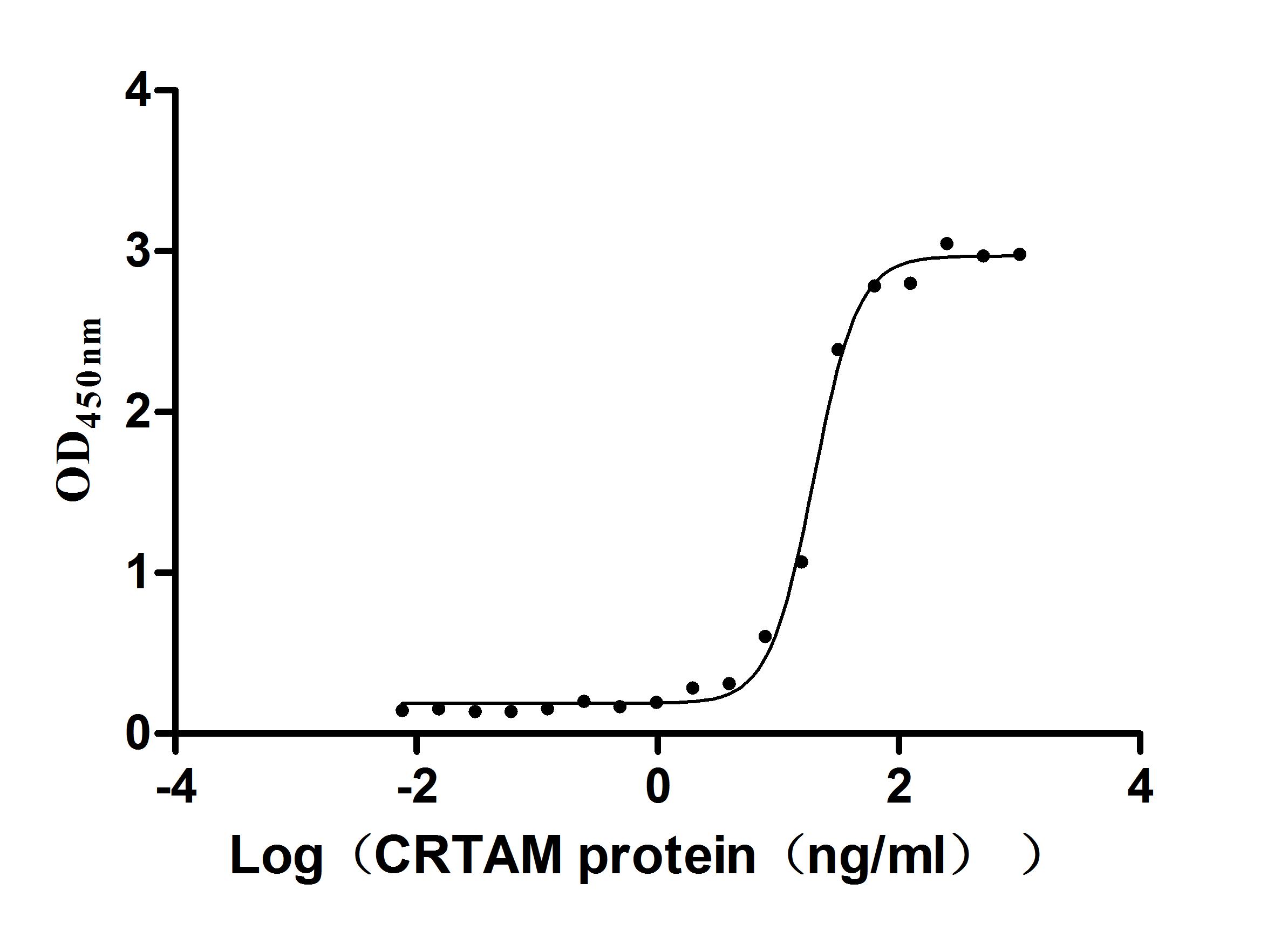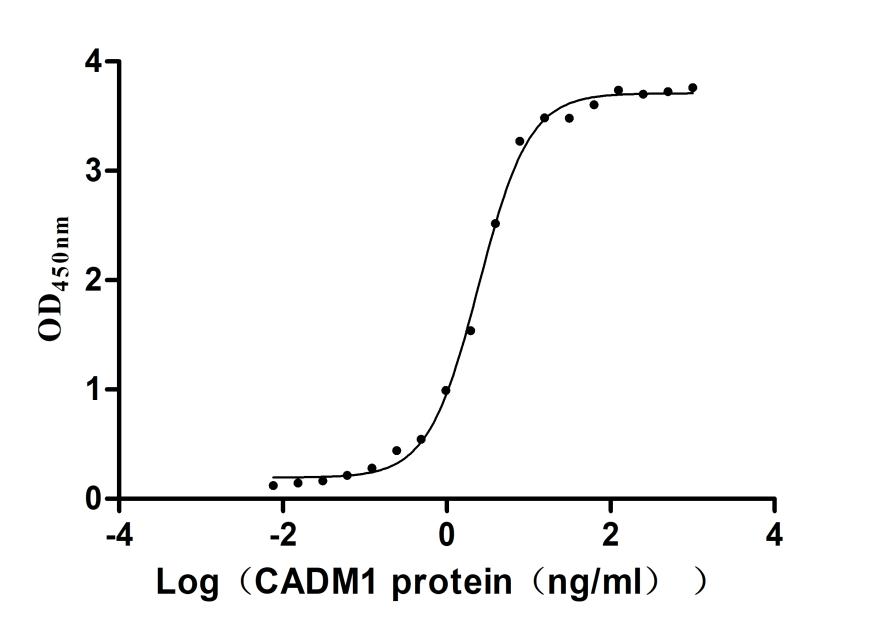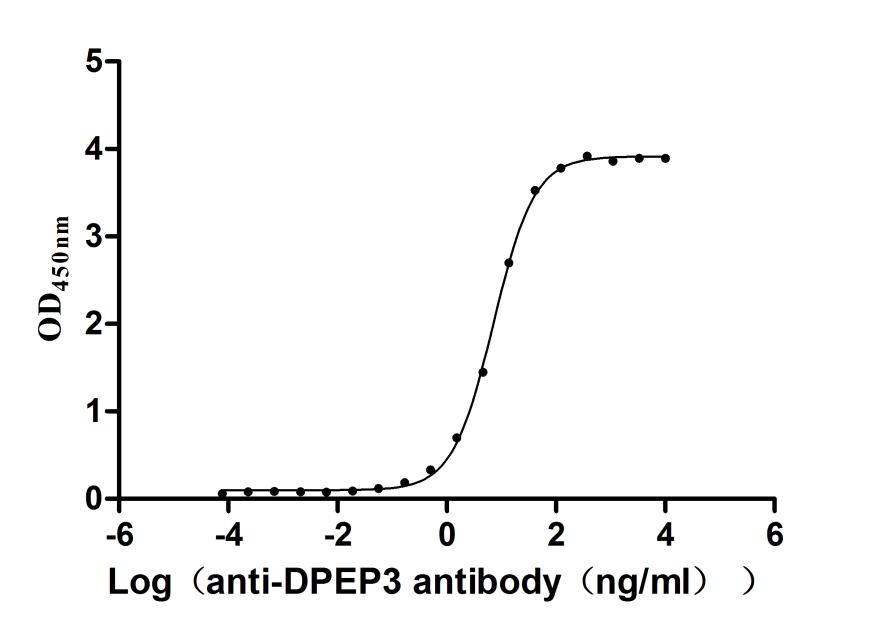Recombinant Human Histone acetyltransferase KAT2A (KAT2A), partial
-
中文名称:人KAT2A重组蛋白
-
货号:CSB-YP821706HU
-
规格:
-
来源:Yeast
-
其他:
-
中文名称:人KAT2A重组蛋白
-
货号:CSB-EP821706HU
-
规格:
-
来源:E.coli
-
其他:
-
中文名称:人KAT2A重组蛋白
-
货号:CSB-EP821706HU-B
-
规格:
-
来源:E.coli
-
共轭:Avi-tag Biotinylated
E. coli biotin ligase (BirA) is highly specific in covalently attaching biotin to the 15 amino acid AviTag peptide. This recombinant protein was biotinylated in vivo by AviTag-BirA technology, which method is BriA catalyzes amide linkage between the biotin and the specific lysine of the AviTag.
-
其他:
-
中文名称:人KAT2A重组蛋白
-
货号:CSB-BP821706HU
-
规格:
-
来源:Baculovirus
-
其他:
-
中文名称:人KAT2A重组蛋白
-
货号:CSB-MP821706HU
-
规格:
-
来源:Mammalian cell
-
其他:
产品详情
-
纯度:>85% (SDS-PAGE)
-
基因名:
-
Uniprot No.:
-
别名:1110051E14Rik; AW212720; EC 2.3.1.48 ; GCN 5; GCN5 (general control of amino-acid synthesis, yeast, homolog)-like 2; Gcn5; GCN5 general control of amino-acid synthesis 5-like 2 (yeast); GCN5L2; general control of amino acid synthesis 5-like 2; General control of amino acid synthesis protein 5-like 2; General control of amino acid synthesis, yeast, homolog-like 2; HGCN5; Histone acetyltransferase GCN5; Histone acetyltransferase KAT2A; hsGCN5; K(lysine) acetyltransferase 2A; KAT2 A; KAT2A; KAT2A_HUMAN; Lysine acetyltransferase 2A; MGC102791 ; PCAF-b; STAF97
-
种属:Homo sapiens (Human)
-
蛋白长度:Partial
-
蛋白标签:Tag type will be determined during the manufacturing process.
The tag type will be determined during production process. If you have specified tag type, please tell us and we will develop the specified tag preferentially. -
产品提供形式:Lyophilized powder
Note: We will preferentially ship the format that we have in stock, however, if you have any special requirement for the format, please remark your requirement when placing the order, we will prepare according to your demand. -
复溶:We recommend that this vial be briefly centrifuged prior to opening to bring the contents to the bottom. Please reconstitute protein in deionized sterile water to a concentration of 0.1-1.0 mg/mL.We recommend to add 5-50% of glycerol (final concentration) and aliquot for long-term storage at -20℃/-80℃. Our default final concentration of glycerol is 50%. Customers could use it as reference.
-
储存条件:Store at -20°C/-80°C upon receipt, aliquoting is necessary for mutiple use. Avoid repeated freeze-thaw cycles.
-
保质期:The shelf life is related to many factors, storage state, buffer ingredients, storage temperature and the stability of the protein itself.
Generally, the shelf life of liquid form is 6 months at -20°C/-80°C. The shelf life of lyophilized form is 12 months at -20°C/-80°C. -
货期:Delivery time may differ from different purchasing way or location, please kindly consult your local distributors for specific delivery time.Note: All of our proteins are default shipped with normal blue ice packs, if you request to ship with dry ice, please communicate with us in advance and extra fees will be charged.
-
注意事项:Repeated freezing and thawing is not recommended. Store working aliquots at 4°C for up to one week.
-
Datasheet :Please contact us to get it.
相关产品
靶点详情
-
功能:Protein lysine acyltransferase that can act as a acetyltransferase, glutaryltransferase or succinyltransferase, depending on the context. Acts as a histone lysine succinyltransferase: catalyzes succinylation of histone H3 on 'Lys-79' (H3K79succ), with a maximum frequency around the transcription start sites of genes. Succinylation of histones gives a specific tag for epigenetic transcription activation. Association with the 2-oxoglutarate dehydrogenase complex, which provides succinyl-CoA, is required for histone succinylation. In different comp...显示更多
-
基因功能参考文献:
- KAT2A/2B acetylation of PLK4 prevents centrosome amplification PMID: 27796307
- Results found that lack of GCN5 decreased the osteogenic differentiation of periodontal ligament stem cells (PDLSCs) and overexpression of GCN5 rescued osteogenic deficiency in PDLSCs from periodontitis patients. Mechanistically, GCN5 regulated DKK1 expression by acetylation of Histone H3 lysine 9 (H3K9) and Histone H3 lysine 14 (H3K14) to regulate Wnt/beta catenin pathway of PDLSCs. PMID: 27216891
- findings reveal an important mechanism of histone modification and demonstrate that local generation of succinyl-CoA by the nuclear alpha-KGDH complex coupled with the succinyltransferase activity of KAT2A is instrumental in histone succinylation, tumour cell proliferation, and tumour development PMID: 29211711
- GCN5 upregulation is especially common in UCCs. GCN5 knockdown impeded growth of specific UCCs, whereas PCAF knockdown elicited minor effects. PMID: 28678170
- Our results suggest that GCN5 is present at telomeres and opposes telomere recombination, in contrast to PCAF that may indirectly favour them in ALT cells. PMID: 28412741
- This report documents a novel lncRNA, GClnc1, which may act as a scaffold to recruit the WDR5 and KAT2A complex and modify the transcription of target genes. This study reveals that GClnc1 is an oncogenic lncRNA in human gastric cancer. PMID: 27147598
- To understand how Gcn5 discriminates between different acyl-CoA molecules, structures of the catalytic domain of human Gcn5L2 bound to propionyl-CoA and butyryl-CoA were determined. PMID: 27377381
- Data suggest that expression of GCN5 (histone acetyltransferase GCN5) is induced in skeletal muscle during a 48-hour fast; in contrast, expression of SIRT1 (sirtuin 1) remains unchanged. PMID: 27525514
- Orc5 associates with the H3 histone acetyl transferase GCN5 (also known as KAT2A), and this association enhances the chromatin-opening function of Orc5. PMID: 26644179
- Methionine was the only essential amino acid that rapidly induced PGC-1alpha acetylation through activating the GCN5 acetyltransferase. PMID: 27022023
- these results may point to the GCN5-NF-kappaB pathway as a novel potential molecular target for stem cell mediated regenerative medicine and the treatment of metabolic bone diseases such as osteoporosis. PMID: 26420353
- Acetyltransferase p300 collaborates with chromodomain helicase DNA-binding protein 4 (CHD4) to facilitate DNA double-strand break repair PMID: 26546801
- Suggest lysine acetyltransfer as a potential regulator of platelet actin dynamics, and potential roles for lysine acetylation in the molecular coordination of platelet activation and function. PMID: 26256950
- Data uncover GCN5 as a negative regulator of C/EBPalpha and demonstrate the importance of C/EBPalpha acetylation in myeloid differentiation. PMID: 27005833
- GCN5 Potentiates Glioma Proliferation and Invasion via STAT3 and AKT Signaling Pathways PMID: 26378521
- results thus demonstrate that the catalytic activity of GCN5 is stimulated by subunits of the ADA2a- or ADA2b-containing HAT modules and is further increased by incorporation of the distinct HAT modules in the ATAC or SAGA holo-complexes PMID: 26468280
- GCN5 plays a positive role in human colon cancer development, and its suppression holds a great therapeutic potential in antitumor therapy PMID: 26637399
- our results represent the first work demonstrating that GCN5 and PCAF exhibit different functions and antagonistically regulate the XBP-1S-mediated transcription. PMID: 25426559
- Gcn5 and PCAF repress IFN-beta production in an enzymatic activity-independent and non-transcriptional manner: by inhibiting the innate immune signaling kinase TBK1 in the cytoplasm. PMID: 25269644
- The antifibrotic effects of SIRT1 in systemic sclerosis were due in part to decreased expression and function of the acetyltransferase p300. PMID: 25707573
- DDIT3 and KAT2A cooperatively up-regulate TNFRSF10A and TNFRSF10B. PMID: 25770212
- HBXIP promotes the migration of breast cancer cells through modulating microtubule acetylation mediated by GCN5. PMID: 25686500
- Genetic studies indicate that Gcn5 and USP22 have important roles during development, which may presage important functions for these proteins in human diseases. [review] PMID: 25111486
- Purified GCN5 binds to an N-terminal sub-domain of MYC TAD. PMID: 24705139
- Expression of PCAF was upregulated in PCa cells through suppression of miR-17. Phenethyl isothiocyanate treatment significantly decreased PCAF expression and promoted transcription of miR-17 in LNCaP cells. PMID: 23661605
- P300 acetyltransferase is a molecular determinant of androge receptor degradation. PMID: 24480624
- PR acetylation at Lys-183 by p300 potentiates PR activity through accelerated binding of its direct target genes without affecting PR tethering on other transcription factors. PMID: 24302725
- These results demonstrate that GCN5, through its acetyltransferase activity, inhibits PGC1alpha-induced enhancement of hepatitis B virus transcription and replication both in vitro and in vivo. PMID: 23913178
- These data provide a first look at quantitating the specificity and selectivity of multiple lysines on a single substrate (histone H3) by Gcn5. PMID: 23437046
- GCN5 has a role in potentiating growth of non-small cell lung cancer by promoting E2F1, cyclin D1, and cyclin E1 expression PMID: 23543735
- GCN5 takes part in transcription regulation of POLH gene through alterations in the chromatin structure by direct interaction with its 5'-flanking region, and protects vertebrate cells against UV-induced DNA damage via controlling POLH gene expression. PMID: 23033487
- GCN5 as a new negative regulator of transactivation by E1A and suggest that its KAT activity is required for optimal virus replication. PMID: 22623781
- acetylation mechanism by GCN5 PMID: 22574209
- Genetic variants in KAT2A does not contribute to the development of Lynch syndrome. PMID: 22086303
- H1.4K34 acetylation is mediated by GCN5 and is preferentially enriched at promoters of active genes, where it stimulates transcription by increasing H1 mobility and recruiting a general transcription factor. PMID: 22465951
- Data show that And-1 forms a complex with both histone H3 and Gcn5. PMID: 21725360
- Human HAT complexes, sharing the same catalytic GCN5 or PCAF subunit are targeted to different genomic loci representing functionally distinct regulatory elements. PMID: 22055187
- GCN5 differentially affects expression of multiple genes; ethanol-induced histone H3-lysine 9 acetylation is mediated via GCN5, and GCN5 is involved in ethanol-induced expression of the putative choline transporter SLC44A2. PMID: 21367571
- Deletion of GCN5/PCAF in cells specifically and dramatically reduces acetylation on histone H3K9. PMID: 21131905
- Data show that Pygo2 associates with MLL2 histone methyltransferase and STAGA histone acetyltransferase to facilitate their interaction with beta-catenin and Wnt1-induced, TCF/LEF-dependent transactivation in breast cancer cells. PMID: 20937768
- In this study the authors demonstrate that another cellular histone acetyltransferase, GCN5, acetylates HIV-1 integrase leading to enhanced 3'-end processing and strand transfer activities. PMID: 20226045
- crystal structure of the GCN5 HAT bound to a peptide-CoA conjugate containing CoA covalently attached through an isopropionyl linker to Lys-14 of a 20-aa N-terminal fragment of histone H3 PMID: 12391296
- requirement in transcription activation via c-myc transformation domain PMID: 12660246
- All human TACC family proteins can bind in vitro to GCN5L2. PMID: 14767476
- GCN5 preferentially controls cell cycle-related genes, as well as apoptosis-related genes PMID: 15715965
- PCAF/GCN5-dependent acetylation of C/EBPbeta serves as an important molecular switch in determining the transcriptional regulatory potential of this transcription factor. PMID: 17301242
- suggest a novel STAF65gamma-dependent function of STAGA-type complexes in cell proliferation and transcription activation by MYC postloading of TFIID and RNA polymerase II that involves direct recruitment of core Mediator PMID: 17967894
- GCN5 regulates CDK9 function by specifically acetylating the catalytic core of the enzyme especially a Lys needed for ATP coordination & the phosphotransfer reaction. PMID: 18250157
- GCN5L acetyltransferase stably associates with Mediator together with the TRRAP polypeptide. PMID: 18418385
- ATAC Is a GCN5/PCAF-containing acetylase complex with a novel NC2-like histone fold module that interacts with the TATA-binding protein PMID: 18838386
收起更多
-
亚细胞定位:Nucleus. Chromosome. Cytoplasm, cytoskeleton, microtubule organizing center, centrosome.
-
蛋白家族:Acetyltransferase family, GCN5 subfamily
-
组织特异性:Expressed in all tissues tested, with most abundant expression in ovary.
-
数据库链接:



















